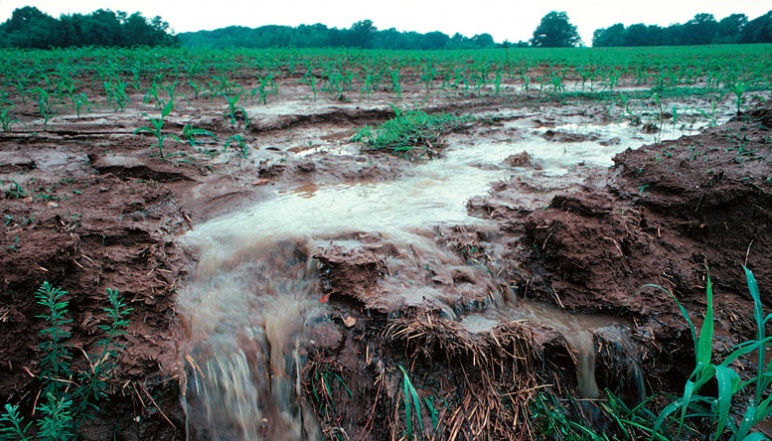Our Research Solving the phosphite bottleneck for next generation agriculture and clean water

View of runoff, transporting nonpoint source pollution, from a farm field in Iowa during a rain storm. (Credit: Lynn Betts, U.S. Department of Agriculture, Natural Resources Conservation Service. Public Domain)
Principal Investigator
Christopher C. Cummins
- Henry Dreyfus Professor of Chemistry
- Department of Chemistry
Christopher (Kit) Cummins' group research embraces chemical synthesis, reaction discovery, reagent development, and mechanistic studies. Under development are anthracene-based precursors to reactive intermediates including P2, aminophosphinidenes, SO, phosphinidene chalcogenides, and other heavier main-group multiply bonded species not stabilized by sterically demanding substituents.
Challenge:
Fertilizer runoff from agricultural practices challenges the health of waterways throughout the world. What alternative fertilizers might be available that support crop productivity as well as water ecosystems?
Research Strategy
- Target the development of phosphite fertilizers formulated to encourage growth of new transgenic crops on the market
- Create a closed-loop system that recovers phosphite from waste streams of wastewater treatment sites
- Engineer the system to operate with minimal energy inputs to reduce the carbon emissions of the process
Project description
Current agricultural practices throughout the world are dependent upon fertilizer to ensure high-yielding crops. However, rains and other climate events lead to nutrient runoff, which can lead to algal blooms, and ecosystem disruption in rivers, streams, and marine ecosystems. But recent advances in plant bioengineering have produced crops—including corn, soybeans, and cotton—that can metabolize phosphite, a reduced phosphorus compound that is not able to be metabolized by non-engineered plants including weeds. This development presents the possibility of using phosphite as both a fertilizer and an approach to weed control. In addition to reducing the negative environmental impact of herbicide use, a strategy built around phosphite fertilizer might address other downsides of excessive use of phosphorus, a nonrenewable resource that is often over-applied. The challenge, however, is that current industrial processes used to develop phosphite are energy intensive, involve mining practices that disrupt land ecosystems, and result in high carbon emissions. Through this research Christopher Cummins, Henry Dreyfus Professor of Chemistry in the Department plans to invent a new, low-energy process for phosphite manufacturing that pulls phosphite from existing waste streams, resulting in a sustainable, closed-loop system that supports crop yields as well as riparian ecosystems.
Outcomes
- Created sustainable synthesis of inorganic phosphite
- Bioproduced polyphosphate from baker’s yeast as a starting material for phosphite production and published the mechanochemical process so that anyone may make use of the technology
- Invented a method for hydride phosphorylation, a new chemical mechanism for phosphate reduction
- Showed that polyphosphates recovered from the environment have great potential for sustainable conversion into value added reduced phosphorus chemicals, illustrating a possible approach to a greener phosphorus industry that may enable next-generation agriculture by making phosphite more economically viable as a phosphorus fertilizer for genetically engineered crops
Publications
Sustainable production of reduced phosphorus compounds: mechanochemical hydride phosphorylation using condensed phosphates as a route to phosphite
Feng Zhai, Tiansi Xin, Michael B. Geeson, and Christopher C. Cummins, ACS Central Science, 2022
Additional Details
Impact Areas
- Water
- Food
- Climate & Sustainability
Research Themes
- Sustainability & Adaptation
- Soil Fertility & Crop Productivity
Year Funded
- 2020
Grant Type
- Seed Grant
Status
- Completed

